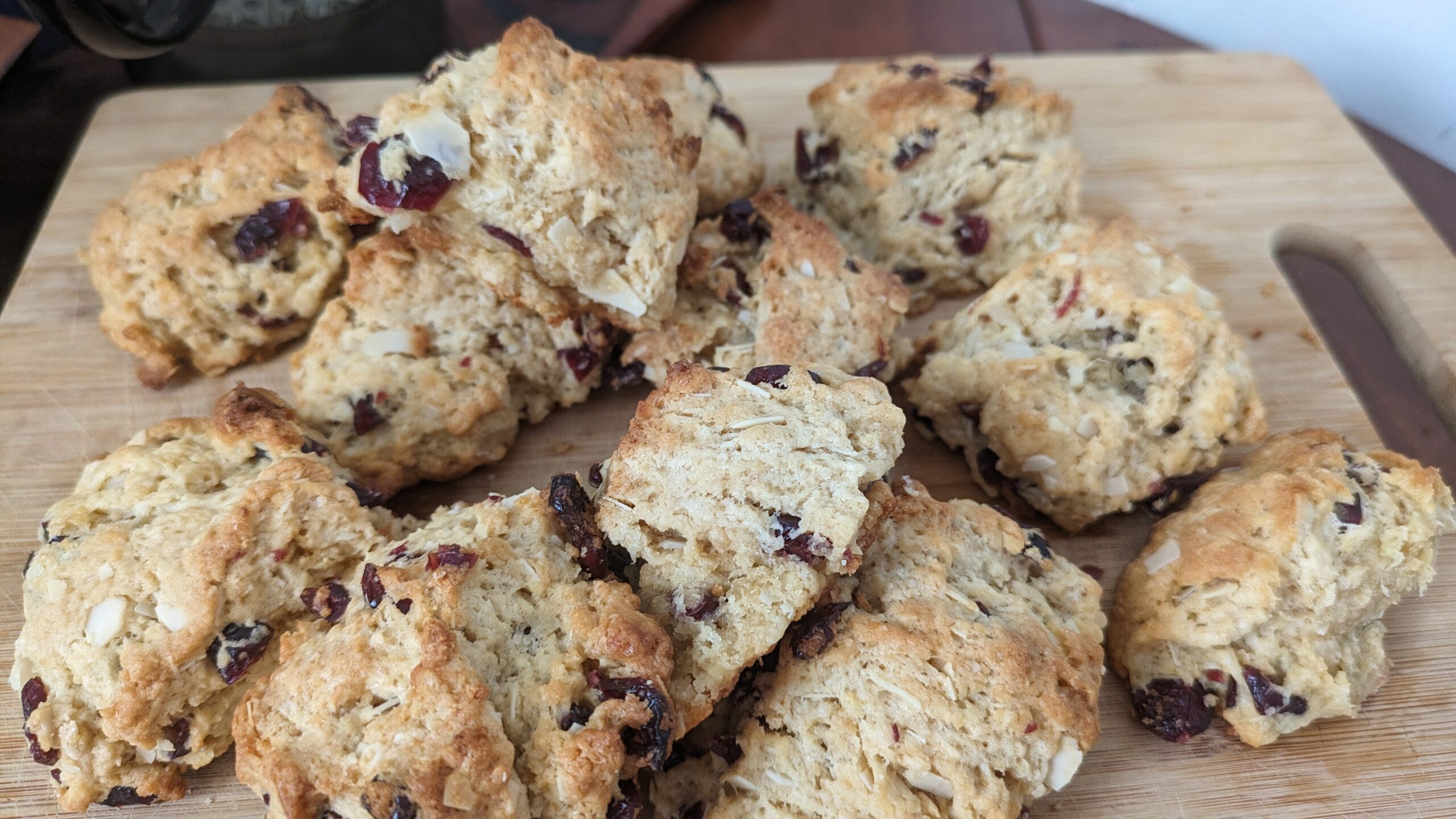Scones
I always thought biscuits, scones and tea biscuits were all the same. However, in bakeries and coffee shops I’d always see these huge wedges of “scone” that looked amazing but I would think to myself, “I can make that, can’t I?” What I was always making were biscuits. My biscuits recipes and variations can be found in another post that I’ll get too, soon enough! Scones, however, I never explicitly made by following a recipe. I finally decided I wanted to try. So, I got out my Betty Crocker, Baking for Today, cookbook and started searching for a scone recipe. With the internet and all the recipes floating around out there including the one I’m going to add to the internet, I go to an old recipe book that was given to me by my mother. Below is the basic scone recipe I extracted from the book and my modification for “Cranberry Almond Scones”! I hope you enjoy them. I have also included a bit more information about the differences between scones and biscuits below too.
Basic Scone Recipe
Recipe
- 1 ¾ c all purpose flour
- 1/3 c packed brown sugar.
- 2 tsp baking power
- ¼ tsp salt
- 1/3 c firm butter or margarine
- 1 egg
- ½ c half and half (or some kind of cream)
Cranberry Almond Scones
Additions
- 1c dried cranberries
- 1/2 c sliced almonds.
Directions
- Heat oven to 400F.
- In large bowl mix Flour, brown sugar, baking power and salt.
- Cut in butter using a pastry blender or pulling 2 table knives through the ingredients in opposite directions until the mixture looks like fine crumbs.
- Stir in egg and half and half until a soft dough forms.
- Stir in pear and pecans.
- On ungreased cookie sheet drop dough by slightly rounded blobs (approximately 1/3c to 1/4 c full)
- Bake 16-18 minutes of until golden brown.
- Immediately remove from cookie sheet.
- Serve Warm
Below are some other combinations that may be nice to try and that I will get to over time.
Scone variations to test and try.
- Cranberry and almond (this was the first one) – 1 c dried cranberries; 1/3 c sliced almonds.
- Lemon pecan – 2 tbsp freshly squeezed lemon juice: ½ c pecan pieces.
- Pear pecan – 1 cup chopped pear; ½ c pecans.
- Cherry chocolate – 1 -1.5 c frozen cherries; 1/2c chocolate chips, chunks, shredded.
- Blueberry lemon – 1 – 1.5 c frozen blueberries; 2 tbsp lemon juice freshly squeeze. Top with lemon zest
- Apple walnut – 1 – 1.5 c chopped apple: ½ c walnut pieces.
- Bacon and cheddar – 1 cup cooked and crumbled bacon: ½ shredded cheese. Top with grated cheese before baking.
- Caramelized onions and brie – 1 c caramelized onions; ½ cup brie. Top with small chunks of brie.
- Chives and parmesan – ½ c – ¾ c chives chopped; 1/3 c parmesan. Top with parmesan before baking.
- Cinnamon apple – 1 – 1.4 c chopped apple: 2 tsp ground cinnamon. Top with cinnamon sugar (Cinnamon mixed in with white sugar.)
- Strawberry white chocolate – 1 – 1.5 cup sliced strawberries (fresh or frozen); ½ c white chocolate, chips or shaved.
Difference between biscuits and scones
I never understood the difference or even realized there was a difference between scones and biscuits. Even biscuits and tea biscuits I didn’t realize there was a difference. I thought it was all in the name and who called it what. But there seems to be a subtle difference. That difference seems to be about texture and thus ingredients.
The Kitchen Magpie explains that the primary difference between scones and biscuits is the inclusion of eggs in scones and not in biscuits. This difference makes scones denser and richer, while biscuits are lighter and fluffier. Both scones and biscuits can vary in sweetness and savoriness, but it’s the egg that changes the texture between these two baked goods.
This difference is also echoed by Lazy Daisy’s Café. Here the main differences they highlight between scones and biscuits, are on their texture, ingredients, and serving methods. Biscuits are described as light, airy, and robust, ideal for savory dishes, while scones are denser, crumblier, and sweeter, typically served with cream or jam. Key differences being scones have more liquid and fatter (including eggs) and usually larger than biscuits. They also mention tea biscuits, mentioning their distinct buttery and flaky texture compared to the dense and crunchy scones.
Biscuits are light, airy, and robust, suitable for savory dishes. Tea biscuits are a subgroup of biscuits with a distinctive buttery and flaky texture. Scones, on the other hand, are denser, crumblier, and typically sweeter, often served with cream or jam. The main differences lie in texture, ingredients (scones have more fat and sometimes eggs, making them richer), and serving preferences, with scones leaning towards sweet accompaniments.

References
- Betty Crocker, Baking for Today, Wiley Publishing, Inc, 2005.
- 24 Scone Recipes That’ll Make your Brunch Better, Lisa Kaminski, Updated, November 2023, Taste of Home, URL: https://www.tasteofhome.com/collection/scone-recipes/
- What’s the Difference Between Biscuits and Scones?, Micah A Leal, Updated September 2023, Southern Living, URL: https://www.southernliving.com/food/bread/scone-vs-biscuit
- Biscuits and Scones, The Kitchen Magpie, URL: https://www.thekitchenmagpie.com/recipes/breads-quick-breads/biscuits-scones/
- Is there a difference between scones and biscuits in Canada? All you need to know about these two treats, Dawn Chapman, August 2022, Lazy Daisy’s Café, URL: https://lazydaisyscafe.ca/blogs/news/biscuits-and-scones-comparison
- Everyone will love this hazelnut spread stuffed cookies recipe - November 18, 2024
- The Greely Good Market is a Modern Outdoor Market - September 3, 2024
- Our Quick Visit to the Petawawa Container Market - September 3, 2024








